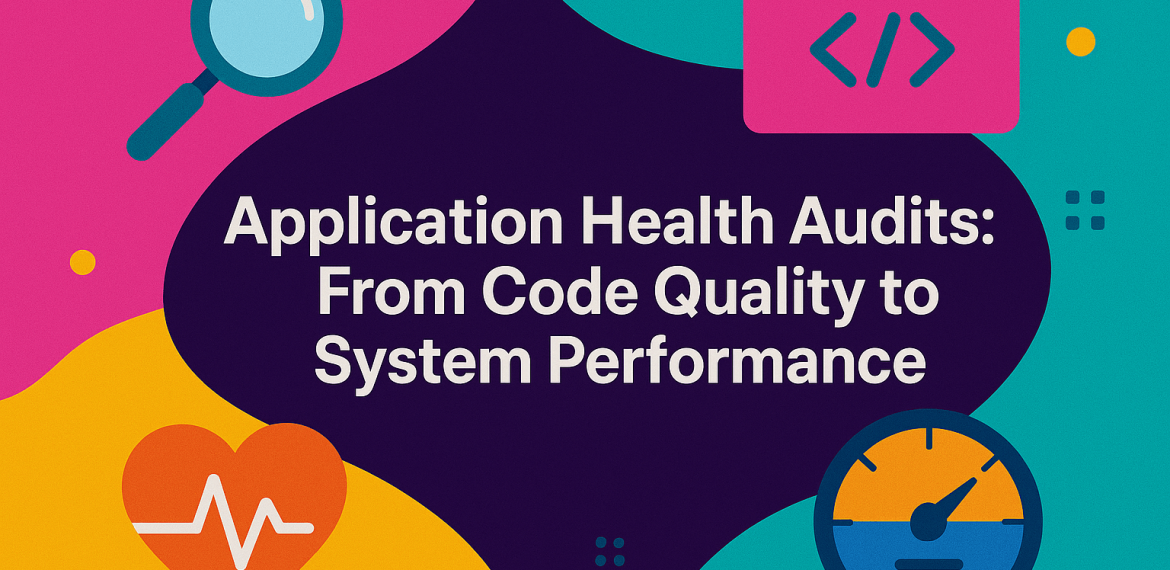
Application Health Audits: From Code Quality to System Performance
Application Health Audits: From Code Quality to System Performance
Application health audits are no longer a luxury – they are a necessity in today’s technology-driven business world. Whether you’re running a fast-paced SaaS platform or an enterprise-grade internal application, the ability to measure, diagnose, and improve your application’s health directly impacts your agility, customer satisfaction, and long-term scalability. A robust audit spans multiple layers, beginning with the codebase and extending all the way to runtime performance, security, and infrastructure resilience.
Understanding the Scope of Application Health
When organizations consider an “application audit,” they often imagine a superficial checklist – maybe a few performance tests or a cursory review of the code. In reality, an effective audit is far more expansive. It must touch on several interconnected areas: source code quality, architectural patterns, system performance under load, deployment workflows, data security, and even incident response capabilities. Each layer feeds into the next, making the whole system either a well-oiled machine or a time bomb waiting to explode.
The Code: Your Foundation for Sustainability
Evaluating Code Quality and Maintainability
The first and most obvious place to start is your codebase. Over time, even the most well-written code can degrade due to rushed deadlines, developer turnover, or shifting business requirements. A health audit should look closely at code smells, redundant logic, over-engineered classes, and inconsistent naming conventions. Tools like SonarQube or ESLint can automate much of this, but human judgment remains critical for assessing whether the code aligns with clean architecture principles.
Testing Coverage and Reliability
The second layer of evaluation focuses on test coverage. This isn’t just about hitting a percentage target. A good audit assesses the effectiveness of your unit tests, the isolation of your integration tests, and the business relevance of your functional tests. The presence of flaky tests or untested edge cases is a warning sign that must be addressed immediately. The goal here isn’t just test confidence – it’s developer confidence.
Eliminating Technical Debt
Dead code, deprecated libraries, and sprawling classes with unclear responsibilities introduce friction every time the team tries to ship something. An audit should track down and document technical debt explicitly, linking each instance to the business or operational risk it represents. This forms the foundation for a prioritized remediation plan.
Architectural Integrity: Scaling Without Breaking
Analyzing Structural Patterns and Layer Separation
Once the code layer is understood, attention must turn to the architecture. Does the application follow a clean separation of concerns? Are service boundaries well-defined, or is logic bleeding between layers? Whether your system uses a monolith, microservices, or a hybrid architecture, the audit should expose coupling issues, unclear API contracts, or over-reliance on synchronous communication patterns.
Microservices and Interoperability Checks
In microservices environments, things get more complicated. Each service must be independently deployable, but also fully observable. Are failures in one service gracefully contained? Is API versioning in place? Is schema evolution being managed properly? These questions help uncover silent issues that may only become visible during scaling, migration, or integration projects.
Versioning and Dependency Hygiene
An overlooked yet critical part of architecture is how well it manages dependencies. The audit should inspect whether external libraries are up-to-date, how breaking changes are tested, and whether there’s a documented policy for adopting new frameworks. Outdated or poorly understood dependencies can introduce significant security and compatibility risks.
Security: Proactive, Not Reactive
Inspecting Identity and Access Controls
Application health is meaningless if the system is vulnerable to intrusion. A proper audit dives deep into authentication mechanisms, access control models, and privilege escalation paths. It checks for insecure session handling, token expiration inconsistencies, and outdated encryption policies. Role-based or attribute-based access control must be implemented consistently across APIs, services, and user interfaces.
Data Flow and Sanitization
A large proportion of security exploits still rely on unsanitized inputs. The audit should examine how data flows from client to server, identifying any potential injection points, unescaped outputs, or content security gaps. Anomalies in how input is validated or sanitized can be devastating – especially if they open the door to SQL injection, XSS, or CSRF.
Vulnerability Management Practices
Security doesn’t end at development. The audit must include a review of your vulnerability scanning tools and patching policies. Are container images scanned on build? Are dependencies audited regularly for CVEs? Is there a process for evaluating and deploying critical patches in production within a defined SLA? These answers distinguish mature teams from exposed ones.
Performance: The User Experience Bottleneck
Benchmarking Real-World Response Times
No matter how elegant your code or architecture is, if the app feels slow, users will churn. Performance audits measure actual response times under real-world conditions. This includes API latency, server response time, and time to first byte. These metrics must be tracked against SLAs and historical trends to spot degradation.
Load and Scalability Testing
Can your system handle a 5x traffic surge? Will a large file upload bring down the database? Load testing simulates high concurrency and stress scenarios to answer these questions. An effective audit evaluates not just peak thresholds but also the elasticity of autoscaling, the readiness of caching strategies, and the resilience of fallback mechanisms under pressure.
Memory Leaks and Runtime Bottlenecks
Modern applications can hide memory leaks and inefficiencies deep within worker threads or container runtimes. A deep performance audit uses profiling tools to inspect heap usage, thread contention, and garbage collection behavior. Any inconsistency in CPU spikes or latency outliers is examined to isolate problematic services or functions.
Deployment and Infrastructure Resilience
CI/CD Pipeline Maturity
Continuous delivery is essential, but pipelines often become fragile over time. The audit should trace a single change from commit to production, identifying bottlenecks, skipped tests, or misconfigured secrets. Are rollbacks easy and automated? Are staging environments reflective of production? These process checks help identify risks hiding in the shadows of deployment automation.
Infrastructure Monitoring and Observability
A healthy application includes robust observability. The audit must verify if log aggregation, metrics collection, and distributed tracing are integrated across services. When something fails in production, the question shouldn’t be “what happened?” but “what anomaly triggered this specific failure?”. A lack of visibility is equivalent to flying blind.
Disaster Recovery and High Availability
Finally, the infrastructure audit must simulate worst-case scenarios. What happens if the primary database fails? Is there a documented, tested DR plan? Are backups happening, and are they restorable? High availability isn’t just about replication – it’s about orchestration, failover readiness, and incident response protocols that are drilled and documented.
Audit Frequency and Governance
Establishing a Regular Cadence
A one-time audit is useful, but ongoing governance is what truly maintains application health. Ideally, audits are run quarterly for mission-critical systems, with deep dives annually. Each cycle should produce a prioritized list of remediation actions, tracked through engineering sprints or OKRs.
Assigning Ownership and Accountability
Every audit should have clear owners for each identified issue. Whether it’s tech leads for code quality, DevOps for pipeline issues, or InfoSec for vulnerabilities – assigning responsibility ensures that findings lead to action. Without accountability, audits become shelf-ware.
Integrating Audits into Strategic Planning
Health audits are not just technical exercises. Their findings must influence budget allocations, roadmap priorities, and staffing plans. For example, consistent performance issues may justify investing in observability tooling. Mounting security debt may require a dedicated remediation sprint. Integrating audit results into planning cycles elevates them from technical tasks to strategic levers.
How Buxton Consulting Can Help
At Buxton Consulting, we specialize in delivering end-to-end application health audits that go far beyond surface-level diagnostics. With decades of experience across enterprise systems, cloud-native platforms, and complex architectures, our experts bring a structured, data-driven approach to evaluating every layer of your application stack.
Full-Spectrum Auditing Expertise
Our methodology covers everything from code quality and maintainability to runtime performance, security posture, and infrastructure resilience. We use industry-leading tools and best practices to identify weaknesses, quantify technical debt, and highlight optimization opportunities. Whether you’re managing a legacy monolith or a microservices-based platform, Buxton tailors the audit scope to your technology, scale, and business objectives.
Actionable Insights and Remediation Plans
Unlike one-size-fits-all assessments, our audits result in prioritized, actionable insights backed by clear metrics. We don’t just point out problems – we deliver remediation roadmaps aligned with your development cycles and organizational goals. From refactoring plans to performance tuning and CI/CD improvements, we partner with your teams to accelerate resolution and adoption.
Security and Compliance Confidence
Our security specialists help you identify hidden vulnerabilities, misconfigurations, and compliance gaps. We apply OWASP standards, perform threat modeling, and integrate automated security scanning into your CI/CD pipelines – giving you the confidence to deploy faster without compromising safety.
Ongoing Governance and Continuous Monitoring
Application health is not a one-time event. Buxton offers ongoing audit programs, KPI dashboards, and post-audit coaching to embed continuous health monitoring into your development and operations workflows. Whether you need quarterly reviews or integration with your DevSecOps framework, we provide the tools and expertise to sustain long-term excellence.
Ready for What’s Next
Planning for a cloud migration, product scaling, or digital transformation initiative? A Buxton-led health audit is the best way to de-risk that journey. Our audits prepare your application for change by exposing unseen bottlenecks, streamlining performance, and ensuring your architecture is ready to scale.
Partner with Buxton Consulting to transform your application audit into a strategic advantage – making your systems faster, safer, and future-proof.
Conclusion: Treat Your Application Like a Living System
Applications evolve. With every feature release, code merge, infrastructure upgrade, or scaling event, something changes. A robust application health audit doesn’t just assess the present – it prepares your system for the future. By auditing everything from code quality to system performance and security posture, you build a foundation that is not only resilient but also adaptable. It’s not about perfection – it’s about continuous improvement. And in today’s digital economy, that makes all the difference.
If your organization hasn’t conducted a full-stack health audit in the past 6 months, now is the time. The cost of inaction is invisible – until it’s not.
Let your next audit be a turning point – not a postmortem.

